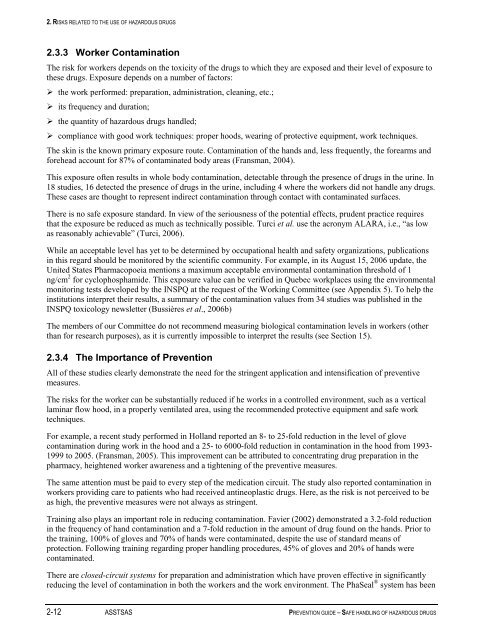Prevention Guide - Safe Handling of Hazardous Drugs - Irsst
Prevention Guide - Safe Handling of Hazardous Drugs - Irsst
Prevention Guide - Safe Handling of Hazardous Drugs - Irsst
Create successful ePaper yourself
Turn your PDF publications into a flip-book with our unique Google optimized e-Paper software.
2. RISKS RELATED TO THE USE OF HAZARDOUS DRUGS<br />
2.3.3 Worker Contamination<br />
The risk for workers depends on the toxicity <strong>of</strong> the drugs to which they are exposed and their level <strong>of</strong> exposure to<br />
these drugs. Exposure depends on a number <strong>of</strong> factors:<br />
‣ the work performed: preparation, administration, cleaning, etc.;<br />
‣ its frequency and duration;<br />
‣ the quantity <strong>of</strong> hazardous drugs handled;<br />
‣ compliance with good work techniques: proper hoods, wearing <strong>of</strong> protective equipment, work techniques.<br />
The skin is the known primary exposure route. Contamination <strong>of</strong> the hands and, less frequently, the forearms and<br />
forehead account for 87% <strong>of</strong> contaminated body areas (Fransman, 2004).<br />
This exposure <strong>of</strong>ten results in whole body contamination, detectable through the presence <strong>of</strong> drugs in the urine. In<br />
18 studies, 16 detected the presence <strong>of</strong> drugs in the urine, including 4 where the workers did not handle any drugs.<br />
These cases are thought to represent indirect contamination through contact with contaminated surfaces.<br />
There is no safe exposure standard. In view <strong>of</strong> the seriousness <strong>of</strong> the potential effects, prudent practice requires<br />
that the exposure be reduced as much as technically possible. Turci et al. use the acronym ALARA, i.e., “as low<br />
as reasonably achievable” (Turci, 2006).<br />
While an acceptable level has yet to be determined by occupational health and safety organizations, publications<br />
in this regard should be monitored by the scientific community. For example, in its August 15, 2006 update, the<br />
United States Pharmacopoeia mentions a maximum acceptable environmental contamination threshold <strong>of</strong> 1<br />
ng/cm 2 for cyclophosphamide. This exposure value can be verified in Quebec workplaces using the environmental<br />
monitoring tests developed by the INSPQ at the request <strong>of</strong> the Working Committee (see Appendix 5). To help the<br />
institutions interpret their results, a summary <strong>of</strong> the contamination values from 34 studies was published in the<br />
INSPQ toxicology newsletter (Bussières et al., 2006b)<br />
The members <strong>of</strong> our Committee do not recommend measuring biological contamination levels in workers (other<br />
than for research purposes), as it is currently impossible to interpret the results (see Section 15).<br />
2.3.4 The Importance <strong>of</strong> <strong>Prevention</strong><br />
All <strong>of</strong> these studies clearly demonstrate the need for the stringent application and intensification <strong>of</strong> preventive<br />
measures.<br />
The risks for the worker can be substantially reduced if he works in a controlled environment, such as a vertical<br />
laminar flow hood, in a properly ventilated area, using the recommended protective equipment and safe work<br />
techniques.<br />
For example, a recent study performed in Holland reported an 8- to 25-fold reduction in the level <strong>of</strong> glove<br />
contamination during work in the hood and a 25- to 6000-fold reduction in contamination in the hood from 1993-<br />
1999 to 2005. (Fransman, 2005). This improvement can be attributed to concentrating drug preparation in the<br />
pharmacy, heightened worker awareness and a tightening <strong>of</strong> the preventive measures.<br />
The same attention must be paid to every step <strong>of</strong> the medication circuit. The study also reported contamination in<br />
workers providing care to patients who had received antineoplastic drugs. Here, as the risk is not perceived to be<br />
as high, the preventive measures were not always as stringent.<br />
Training also plays an important role in reducing contamination. Favier (2002) demonstrated a 3.2-fold reduction<br />
in the frequency <strong>of</strong> hand contamination and a 7-fold reduction in the amount <strong>of</strong> drug found on the hands. Prior to<br />
the training, 100% <strong>of</strong> gloves and 70% <strong>of</strong> hands were contaminated, despite the use <strong>of</strong> standard means <strong>of</strong><br />
protection. Following training regarding proper handling procedures, 45% <strong>of</strong> gloves and 20% <strong>of</strong> hands were<br />
contaminated.<br />
There are closed-circuit systems for preparation and administration which have proven effective in significantly<br />
reducing the level <strong>of</strong> contamination in both the workers and the work environment. The PhaSeal ® system has been<br />
2-12 ASSTSAS PREVENTION GUIDE – SAFE HANDLING OF HAZARDOUS DRUGS

















